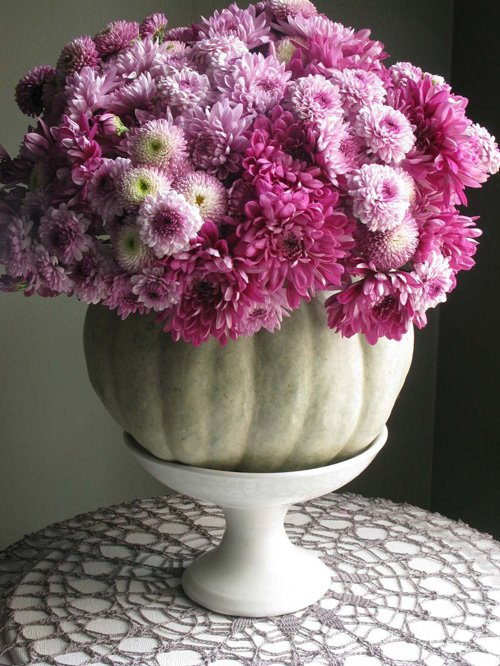Last week I received a very kind email from a reader named David Jimenez telling me how much he enjoyed reading my blog and learning more about Martha’s ventures, her homes and her magazines. I always respond to personal emails regarding Martha Moments and I was happy to do the same for David. I thanked him for his compliments and soon discovered the subtle link to his website in his original message to me.
Well, when I followed the link I was blown away by the visual feast that awaited me and realized that I had to feature him on the blog!
I quickly discovered that David is an incredible designer, renowned across the United States for his classic visual underpinnings and clean, collected style. Born in New York, he has lived in San Francisco and now currently resides in a restored 1906 manor house in Kansas City. He is Vice President of Visual Merchandising for Hallmark and has enjoyed similar positions for companies like Restoration Hardware and Pottery Barn. In this capacity, David is responsible for designing the look and layout of the stores, keeping in mind the design philosophies and themes of the retailer while never forgetting his own personal tastes and attractions, which guide his aesthetic.
 David kindly agreed to a Martha Moments interview, which you can read below. He also graciously sent these incredibly beautiful photographs of his homes: a stunning manor in Kansas City with an adjacent carriage house, and a dreamy vacation home in Palm Springs. Thank you David!
David kindly agreed to a Martha Moments interview, which you can read below. He also graciously sent these incredibly beautiful photographs of his homes: a stunning manor in Kansas City with an adjacent carriage house, and a dreamy vacation home in Palm Springs. Thank you David!
How did you come to find your extraordinary home in Kansas City?
It was love at first sight. I was exploring neighborhoods as possible options for my move to Kansas City from San Francisco in January, 2005. This is one of the first houses I saw. I loved everything about it, from the copper dormer windows to the buff color brick and molding details. It’s what I envisioned as the quintessential Kansas City home.
 You’ve said your approach to decorating is organic and that it doesn’t follow a particular pattern of rules. What inspires you in design and how might you describe your style?
You’ve said your approach to decorating is organic and that it doesn’t follow a particular pattern of rules. What inspires you in design and how might you describe your style?
I would describe my style as casual, collected, personal and inviting.
I am passionate about flea markets and thrift stores because I love the character and warmth that vintage pieces lend to a room. I often allow the items I purchase influence the color palette or point of view for a particular room.
A good example of this is the Chesterfield sofa that’s in my sunroom. It’s an old Ralph Lauren sofa I purchased at a thrift store. It was in terrible shape.
I had it reupholstered in brown velvet and added the dining table, vintage lamps, wing chairs and rug to the room.
So what was once a tattered-looking sofa became the anchor to one of my favorite rooms in the house. You'll notice the Ralph Lauren Chesterfield in the sunroom, seen in this photo.
 The Carriage House behind the main house is such a beautiful and luxurious space. Describe the carriage house and your approach to designing it.
The Carriage House behind the main house is such a beautiful and luxurious space. Describe the carriage house and your approach to designing it.
I lived in the carriage house for a year and a half while I upgraded the main house.
At the time I set it up with my furniture from San Francisco, which had a more contemporary vibe and created a nice contrast against the classic architecture of the main and carriage houses, both built in 1906.
After moving to the main house, I took most of the furniture in the carriage house to the attic and made the space warmer by changing some of the furnishings.
 The living room in the carriage house.
The living room in the carriage house. The office in the carriage house.
The office in the carriage house.
As VP of Visual Merchandising for Hallmark, and previously for Restoration Hardware and Pottery Barn, you obviously have a breadth of experience working in design. How does your professional design intersect with your personal design?
I think it happens in reverse. What I do at home influences what I do at work. Ever since I was young enough to move the furniture around in my parents living room, I have enjoyed trying new ideas and mixing things up.
The spaces I created at Pottery Barn and Restoration reflected the same sensibility I loved in my surroundings at home.
 The living room in the main house.
The living room in the main house.
 The sitting room in the main house.
The sitting room in the main house.
In your Palm Springs house, you use yellow so effectively, like little bursts of sunlight around the rooms. I’ve always found it a difficult colour to work with. What are your secrets to using vibrant tones in interior design?
I wanted the house in Palm Springs to give a nod to the classic “rat pack” era of the 1950’s.
I chose an edited color palette and used the citron yellow color as an accent on a few walls throughout the house. For me, the key with working with such a bright color was to use it sparingly for drama. I also coated the floors in white epoxy to unify all the rooms and create a floating sense of lightness in the house. This also creates a breezy transition between indoors and outdoors.
 The living room in Palm Springs.
The living room in Palm Springs. The dining room in Palm Springs.
The dining room in Palm Springs.
You’ve said that flea markets, tag sales and second-hand shops have yielded numerous treasures for your own design. Considering these economically challenging times, many people might now consider interior design to be an elusive luxury. How can timeless interior design be achieved, even on a low budget?
Nothing gives a room more character than a unique, one-of a kind find that resonates emotionally. I look for interesting pieces that have unique lines, and often re-paint or reupholster the items to fit my décor. And not only is it less expensive than buying from a traditional furniture store— shopping thrift stores, estate sales and flea markets is also the quintessential way to “go green.”
 A serving buffet in the dining room.
A serving buffet in the dining room.
A reupholstered chair in the bedroom.
You obviously admire Martha Stewart otherwise you wouldn’t be a reader of this blog. What makes you a Martha fan?
Martha is an icon and has had a huge impact on American design. I’ll always remember how much I enjoyed reading the first issue of the magazine. I immediately became hooked by her message. It’s been wonderful to see how she has evolved her brand over the years. I continue to be a huge fan of hers.Martha has said recently that a standalone Martha Stewart store is not out of the realm of possibility. How might David Jimenez approach visual merchandising for The Martha Stewart Store? What would I see if I walked through the doors after you had designed the space?
A space the reflects the personal viewpoint and clarity of her brand: Inspirational, clean, edited, well-organized... and with a lot of soul.
What are some things at home you can’t live without?
Fifteen-watt light bulbs, they cast the warmest glow. Baies Candles by Diptyque, my all-time favorite scent. My CD collection with favorites from Aretha to Amy Winehouse. A cocktail shaker, always at the ready. And good friends which leave me feeling loved...and with an occasional hangover.
 Low, atmospheric lighting is a Jimenez feature, such as here in the study of his Kansas City home.
Low, atmospheric lighting is a Jimenez feature, such as here in the study of his Kansas City home.
What are some things we would never, ever see in a David Jimenez interior?
Great question! Truth is, similar to fashion, what’s old starts looking new again if enough time has passed.
The one thing you’ll probably never see in one of my interiors is plastic-covered furniture.
I have plenty of painful memories of being a kid at my grandmother’s and having my skin stick to the sofa while wearing shorts and a hang-ten tank top on hot summer days.
 I have a soft spot for Michael Boodro since he graciously replied to a letter I had written to him in December. It was handwritten on MSLO stationery (above) and personally signed by him. He thanked me for my kind words and actually mentioned Martha Moments! I was very pleased. He will be missed and I certainly wish him the best of luck in his future endeavors!
I have a soft spot for Michael Boodro since he graciously replied to a letter I had written to him in December. It was handwritten on MSLO stationery (above) and personally signed by him. He thanked me for my kind words and actually mentioned Martha Moments! I was very pleased. He will be missed and I certainly wish him the best of luck in his future endeavors!  I have a soft spot for Michael Boodro since he graciously replied to a letter I had written to him in December. It was handwritten on MSLO stationery (above) and personally signed by him. He thanked me for my kind words and actually mentioned Martha Moments! I was very pleased. He will be missed and I certainly wish him the best of luck in his future endeavors!
I have a soft spot for Michael Boodro since he graciously replied to a letter I had written to him in December. It was handwritten on MSLO stationery (above) and personally signed by him. He thanked me for my kind words and actually mentioned Martha Moments! I was very pleased. He will be missed and I certainly wish him the best of luck in his future endeavors! 


















 David kindly agreed to a Martha Moments interview, which you can read below. He also graciously sent these incredibly beautiful photographs of his homes: a stunning manor in Kansas City with an adjacent carriage house, and a dreamy vacation home in Palm Springs. Thank you David!
David kindly agreed to a Martha Moments interview, which you can read below. He also graciously sent these incredibly beautiful photographs of his homes: a stunning manor in Kansas City with an adjacent carriage house, and a dreamy vacation home in Palm Springs. Thank you David!

 The living room in the carriage house.
The living room in the carriage house.
 The living room in the main house.
The living room in the main house. The sitting room in the main house.
The sitting room in the main house. The living room in Palm Springs.
The living room in Palm Springs. The dining room in Palm Springs.
The dining room in Palm Springs. A serving buffet in the dining room.
A serving buffet in the dining room. Low, atmospheric lighting is a Jimenez feature, such as here in the study of his Kansas City home.
Low, atmospheric lighting is a Jimenez feature, such as here in the study of his Kansas City home.







